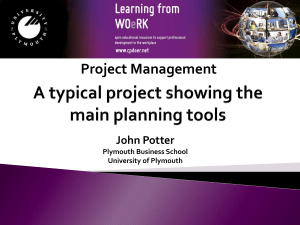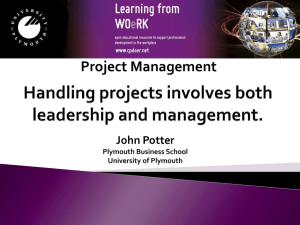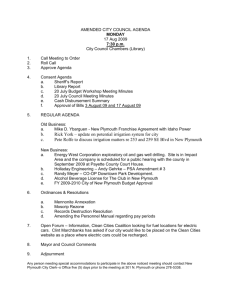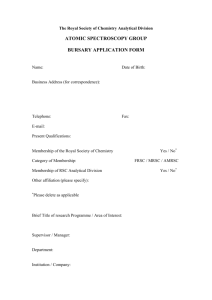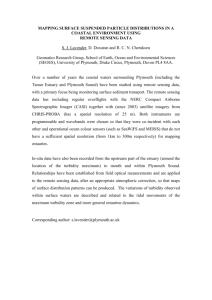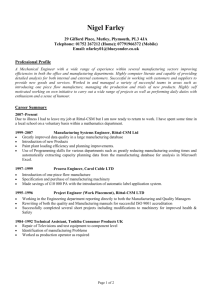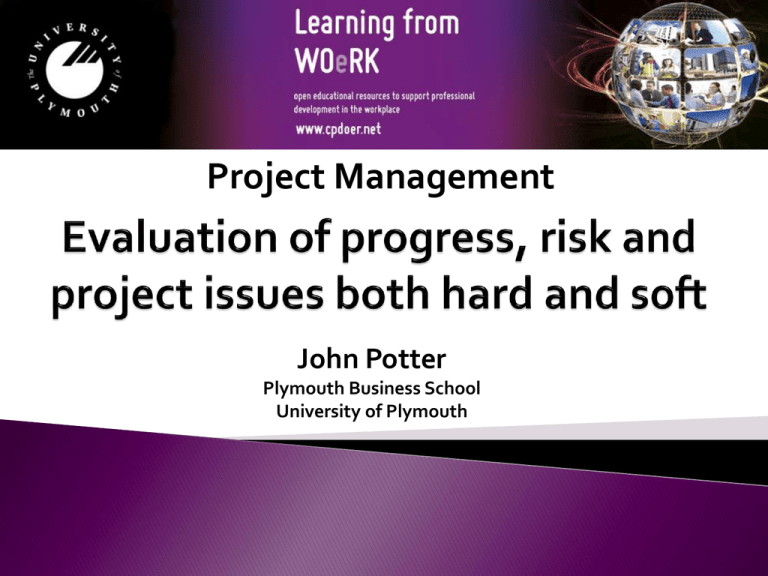
Project Management
John Potter
Plymouth Business School
University of Plymouth
Evaluation of progress
• Once the context of the project is understood, success
criteria identified, plans created and the team assembled it
is important to monitor progress
•It is important to plan ahead to avoid the tendency for the
project leader to ‘fire fight’
•Project control and monitoring tools need to be
appropriate to the project
•The project team needs to perform to a high standard and
cope effectively with changes
•All stakeholders must remain committed to the project as
developments occur
•As the project proceeds the context or ‘Big Picture’
provides the basis for testing whether all the elements are
still on track.
Continuous planning and
review
• Planning is not just carried out at the start of the project but
needs to take place throughout its development
•Continuous cycles of planning, doing and reviewing must
take place – the greater the uncertainty and innovation
involved the more important is this process
•Regular meetings need to take place and the SCRUM
approach takes particular account of this issue
•A SWOT analysis can sometimes be useful at various stages –
what’s going in our favour (strengths)?
•Where are we vulnerable – (weaknesses)?
•What can we capitalise upon to carry us forwards
(opportunities)?
•What can derail us (threats)?
Introspection, progress analysis and reflection are
useful tools although for many people who are action
oriented they do not come naturally
Learning theory shows that the natural process of
reflection is key in promoting effective learning,
something the project team needs to engage in
constantly
The concept of taking the ‘helicopter view’ whilst
addressing specific issues in a ‘split screen’ mode is
valuable as part of the ongoing evaluation process
In the past project control systems were seen as a prerequisite
for success in implementing a project
Current thinking is that we need to add three important issues:
◦ The prime role of a monitoring system is not to control the project
but to provide information to enable the team to manage the
project effectively
◦ The systems must be simple in order to be effective and not an end
in themselves
◦ The systems used must have the support of the whole team
The planning review system involves the review phase,
discussions with stakeholders, adjusting the plan and then
taking action
This leads to the concept of plan-do cycles as in the next slide.
Plan
Discussions with
stakeholders to agree
revisions
Do
Review by project team in the
light of events
Identification of intermediate targets
Critical event-times or bottlenecks
Costs incurred and resources used
Quality assurance
Performance specifications
Managing the people issues.
Project risk management is defined by the Project
Management Body of Knowledge (PMBOK) as…
“ the processes concerned with identifying, analysing and
responding to uncertainty. It includes maximising the
probability and consequence of positive events and minimising
the probability of adverse events to the project objectives
The Association of Project Managers defines project risk as….
“the factors that may cause failure to meet the project’s
objectives …or limit the achievementof your objectives as
defined at the outset of the project
Risk may present from a number of sources as we will see in the
next slide.
Project Management Institute (2009) A Guide to
the Project Management Body of Knowledge:
PMBOK Guide.
Natural risks – use statistics, probability data and draw on the
experience of others as well as yourself.
Product liability risks – thorough planned testing, product recall
and effective quality management
Technical risks – build in extra budget, prototypes, milestone
performance reviews
Business risks – good leadership, use experts where appropriate
and be aware of the early signs of possible problems
Personnel risks – build in contractual agreements, make it a
good place to be, no strike agreements
Psychological risks – have a good coach and mentor, talk
through issues with colleagues.
Poor risk assessment and lack of effective PRAM
(project risk analysis and management)
Lack of project management authority
Poor estimating
Poor planning
Ineffective project team management
Unclear objectives
Poor monitoring and control
Lack of learning from mistakes.
References
Slack. N., Chambers. S. & Johnson, Right. (2001) Operations Management.
Prentice Hall
Briner, W, Geddes, M, Hastings ,C (1990) Project Leadership. Gower:
Aldershot, England.
Project Management Institute (2009) A Guide to the Project Management
Body of Knowledge: PMBOK Guide.
This resource was created by the University of Plymouth, Learning from WOeRk project. This project is funded by HEFCE
as part of the HEA/JISC OER release programme.
This resource is licensed under the terms of the Attribution-Non-Commercial-Share Alike 2.0 UK: England
& Wales license (http://creativecommons.org/licenses/by-nc-sa/2.0/uk/).
The resource, where specified below, contains other 3rd party materials under their own licenses. The licenses
and attributions are outlined below:
1.
The name of the University of Plymouth and its logos are unregistered trade marks of the University. The University reserves all rights
to these items beyond their inclusion in these CC resources.
2.
The JISC logo, the and the logo of the Higher Education Academy are licensed under the terms of the Creative Commons Attribution
-non-commercial-No Derivative Works 2.0 UK England & Wales license. All reproductions must comply with the terms of that license.
Author
John Potter
Institute
University of Plymouth
Title
Evaluation of progress, risk and and project issues both hard and soft
Date Created
10/06/2011
Educational Level
Level 5
Learning from WOeRK Work Based Learning WBL Continuous
Professional Development CPD leadership and management UKOER
LFWOER
Keywords
Text for audio
©University of Plymouth, 2010, some rights reserved
Back page originally developed by the OER phase 1 C-Change project

